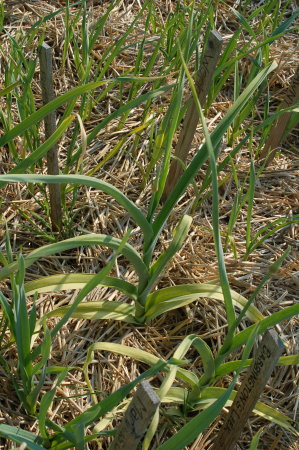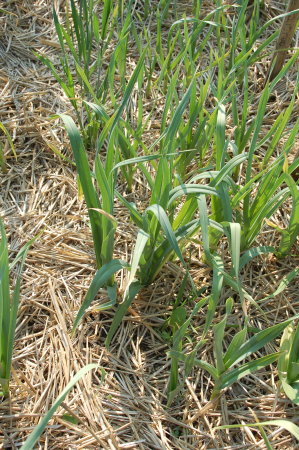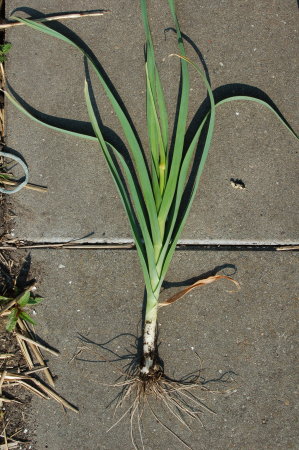I’ve made several posts lately about perennial onions, which I really like. There is also a type of perennial leek called Babington’s Leek. While the plants right now have sent up a flower stalk or scape, so I assume it can be propagated that way, the plants also form roots that look very similar to a bulb of garlic and can be broken apart and replanted.
It’s not uncommon for me to receive the same plant from two different sources, for example because I make a mistake on a seed order or someone gives me a ‘free’ packet of seeds or plant as a gift. That’s what happened here in a way, about a week apart I first got some Babington’s Leek from Lieven, then Søren sent me some as a ‘free gift’ together with some other things he sent me.
The world of plant trading is very small here in Europe, so I assumed 2 or 3 generations back these must have originally come from the same person, but at the same time they looked different so I decided to plant them in separate spots and compare them.
I’m sorry, they are growing in and amongst my garlic and the straw background makes them hard to photograph clearly.
This is Søren’s Babington’s Leek:

and this is Lieven’s:

The main difference is Søren’s plants have a slight yellow color, and the leaves are more horizontally extended. Lieven’s is a darker green color and looks more like a small normal leek.
We had one of Lieven’s leeks for dinner tonight in a salad:

It’s a little hard to see in this picture, but the end is a little swollen probably because it is forming root divisions.
The taste was very nice, and much like a standard leek.
If propagation is only possible from root divisions, it’s going to take a long time before I have a reasonable number in my garden. I think Søren’s only forms two divisions, and Lieven’s four or five.
In a conversation about a year ago Lieven mentioned he sometimes comes across root divisions in standard leeks, so perhaps it’s not strange that Søren and Lieven would send me different varieties of Babington’s Leek, because perhaps it’s a common trait but modern varieties have just been selected for not dividing at the root. Maybe there are lots of varieties around. Is anyone else growing this? It might be interesting to trade.


Hi Patrick,
my variety comes from a danish botanist, could easily be a different strain from Lieven’s.
You will find it setting a lot of topsets, in two years you can have a lot of plants.
Soren has beaten me to it (not surprisingly, as I was away from my machine most of the weekend). Babbington’s Leek makes loads of topsets, which are the best way to increase supplies. The root bulbs are more like elephant garlic.
I’m very interested in this. I have been trying to obtain some Babbingtons Leek without knowing much about them. I just been given some top bulbils from one of two known sources to me. (early March)I have planted them and hope for the best and distributed some around friends too. The first thing that occurs to me is how like the Egyptian Onion the top bulbils are. My other source says that I will be better to wait until summer when the bulbils have newly set. I look forward to tasting them and comparing them with both Elephant garlic and more traditional leeks. I note that other leeks and E garlic produce root bulbils, but that these are often dormant for a year or so. Do you know how to break the dormancy? (I am a forager, seed saver, supporter of the National Heritage Seed Library and The National Vegetable Society, but personally look for useful perennial plants that save work and might fit into a permaculture aim.) David Wall
Hi David,
The allium family (onions, garlic, etc) is very diverse and many of the plants are very different from one another. I have not personally encountered dormancy in bulbils or topsets before. It doesn’t mean it’s not so, but I doubt it’s very common. If you do encounter it, it’s normally broken with warm/cold weather cycles (you might be able to simulate this by putting them in the freezer for a few weeks), and it may result in simply a lower ‘germination’ rate of the bulbils so you can simply plant more of them. I have only seen dormancy in allium seeds.
Topsetting alliums normally form these with the summer solstice. They usually last a while, several months at least, and it’s not normally very important when you plant them. In any case, if you are interested in more perennial onions, get in touch around mid summer and maybe I’ll have some topsets I can send you.
OK Patrick. Thank you. David